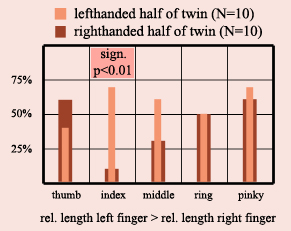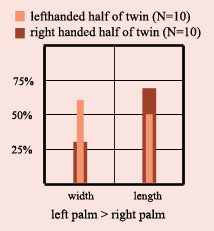
LEFT-HANDEDNESS & LEFT-HANDEDNESS PICTURE THIS:
To be continued!
THE HANDS OF IDENTICAL TWINS!


On the 9th of april 2005 I was invited by TROS - a Dutch broadcasting organisation - to provide some assistence during the recordings of a television project called 'The Twin-test': the search after the most identical twins living in The Netherlands.
During the recordings I have been able to find and contact 10 so-called 'mirror-twins',
which are e.g. characterized by left- and right handedness within each twin couple.
One should notice that 'mirror-twins' are probably the ideal research population for this handness morphology project!
Since these left- and righthanded twin subjects are characterized by a high degree of common biological features.
I would like to thank the TROS + Palazinna TV productions for providing me the time and opportunity to make handscans of each 'mirror-twin' couple.
Each of the twin subjects has also performed the Dutch Handedness Questionnaire.
The following is meant to represent a brief overview of the first results:
leftward fingerlengty asymmetry
In the section LEFT-HANDED is being described that in a sample of Dutch students the hands of left-handers are frequently characterized by long fingers in the left hand compared to the right hand.
However, significant results were only found related to the index fingers of female subjects.
Now, how about the hands of 'mirror-twins'?
The following figure is meant to present a likewise research approach regarding the hands of the 'mirror-twins'.

The RESULTS:
Thorough measurements on the hands of the 'mirror-twins' have indicated that likewise results are being observed when the attention is focussed on the relative finger length differences between both hands (NOTE: relative refers to the length of a finger compared the length of the palm).
More specific: a significant relationship is noticed between the relative length of the index finger and the results of the Dutch Handedness Questionnaire (R=0.51, p=0.010).
& handpalm asymmetry
In the section LEFT-HANDED is being described that in a sample of Dutch students the hands of left-handers are frequently characterized by a wider left hand and a longer right.
However, significant results were only found related to the width of the palm.
Now, how about the hands of 'mirror-twins'?
The following figure is meant to present a likewise research approach regarding the hands of the 'mirror-twins'.

The RESULTS:
Thorough measurements on the hands of the 'mirror-twins' have indicated that likewise results are being observed when the attention is focussed on the width and length differences between both palms.
Despite the non-significant results in the figure, actually a significant result is found between the width differences between the palms and the results of the Dutch Handedness Questionnaire (R=0.42, p=0.033).
And considering the shape differences between both palms (shape = palm width/palm length) the result becomes even more significant (R=0.44, p=0.026).
These results indicate that the hands of the left-handed twin subject are usually characterised by a longer index finger on the left hand and more square shaped left palm compared to the hands of the right handed identical twin brother or sister.
(By the way ... when will you participate in this program???)